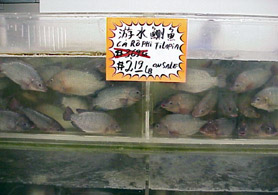Home > News > Press Releases > 2007 > DIRECTORY OF LIVE SEAFOOD MARKETS AND RESTAURANTS IN NORTHEASTERN U.S. NOW AVAILABLE
DIRECTORY OF LIVE SEAFOOD MARKETS AND RESTAURANTS IN NORTHEASTERN U.S. NOW AVAILABLE
Booklet the Result of NJ Department of Agriculture Live Seafood Marketing Study
For Immediate Release: August 24, 2007Contact: Lynne Richmond
(609) 633-2954
(TRENTON) – Live seafood is a significant part of some people’s cultures, for others, it is the best way to ensure their food is as fresh as it can be. To aid consumers in finding markets and restaurants from Maine to Virginia that sell their seafood live, the New Jersey Department of Agriculture has compiled a directory, “Live Seafood: The Best Test of Quality.”
“There are many ethnicities out there that have an interest in purchasing live seafood, but may not know of its availability,” said New Jersey Secretary of Agriculture Charles M. Kuperus. “This multi-lingual consumer directory is designed to facilitate sales by helping people find places where they can make live seafood purchases. The live seafood market is an important component of New Jersey’s seafood sector, and the goal of the directory is to help stimulate the live seafood industry.”
The directory is the result of a two-year-long survey of consumers, producers, wholesalers and buyers in the Northeast about consumption of live fish, shellfish and other seafood products. The study was conducted by the New Jersey Department of Agriculture, in cooperation with Rutgers University and the University of Delaware, and paid for with a $56,500 matching grant from the United States Department of Agriculture’s Federal-State Marketing Improvement Program (FSMIP). The grant’s purpose was to help promote the production and consumption of locally grown live seafood products.
The consumer directory is available online at: www.jerseyseafood.nj.gov/Ethnic%20Live%20Seafood%20Directory%20web.htm. Requests for the print version can be sent to jerseyseafood@ag.state.nj.us. The directory is not a complete listing of all markets and restaurants in the region that offer live seafood, only those that confirmed their willingness to be listed.
In addition, the Department worked with the Sea Grant and College of Marine Science at the University of Delaware to compile and publish a list of producers of live seafood products, both commercial fishermen and aquaculturists, which was produced to make buyers aware of the diversity of domestic production in the Northeast. The Business Network Directory of Live Seafood focuses on, but is not limited to, the Northeast. This guide is available online at www.jerseyseafood.nj.gov/BusinessNetworkDirectory.htm or by e-mailing jerseyseafood@ag.state.nj.us.
The study was conducted at live seafood markets and restaurants in and around Boston, New York City, Philadelphia, and Washington D.C.The survey found that 85 percent of those interviewed at these markets were Chinese. The main reasons respondents gave for seeking out live seafood was for quality, freshness and health benefits. Another major reason was tradition in their families and cultures. Tilapia and hybrid striped bass were the most preferred items purchased at these markets.
“Live seafood has its roots as an ethnic niche market, but with a multitude of ethnicities calling the region home, it is gaining in mainstream familiarity, especially among seafood lovers looking for a unique dining experience,” said Joseph J. Myers, aquaculture development specialist with the Department and principal investigator in the project.
For more information about the live seafood study, visit www.jerseyseafood.nj.gov/ethnicstudy.htm.



